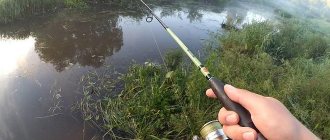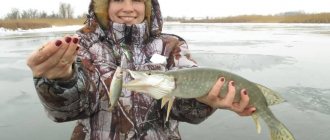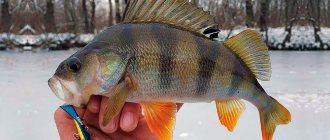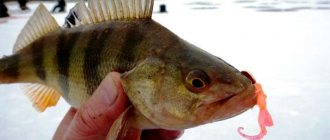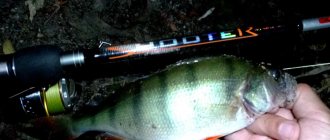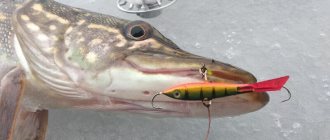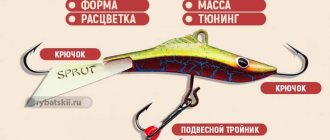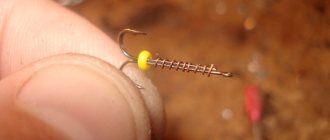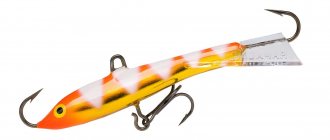Good afternoon dear fishermen. Catching perch in winter is a special type of fishing, since not every fisherman can catch a decent trophy. In order to do this, you need to keep a lot of useful information in your head, from what is best to fish for at this time of year to an almost detailed map of the bottom relief.
With the onset of cold weather, ice appears on many bodies of water and many winter fishing enthusiasts are in a hurry to open the season. It often happens that it is with this minke whale that the season begins. This can be explained by the fact that in the first weeks of winter the perch does not lose its activity and attacks the offered bait with almost the same greed as in the summer.
How to catch perch in winter
Catching winter perch is, in its own way, an ongoing experiment and a constant search for catchable places. The principle came, drilled and sat all day in one place, it doesn’t work at all. With rare exceptions, it is possible to find the very point where another flock is standing the first time. Very often you will have to run after this place.
Basically, to find an advantageous place, in every sense of the word, experienced fishermen will use all their knowledge and experience. Experienced fishermen can already roughly understand where to look for a striped fish, but where it won’t even show its nose.
If you are serious about finding a good striped trophy, then get ready to drill a huge number of holes and have a supply of bait and various kinds of bait with you. Because the perch just doesn’t give up. Sometimes during one fishing trip you have to drill dozens of holes and change more than one gear before finding the golden mean. Here the saying “Legs feed the wolf” comes into play; you will have to run for a good trophy, but it’s worth it.
Perch parking spots
Perch remains active almost all year round and very rarely goes into so-called hibernation. But be that as it may, winter still leaves its mark on it. This happens if the ice has been standing for a long time; the oxygen reserves in the water become scarce, and the water becomes colder.
Perch is a predator and, like pike, it will move after its prey. But he almost always has his favorite feeding places, and if you are lucky enough to find such a place, then consider yourself very lucky.
But despite this, perch very often leaves its home during the day and goes in search of a better life. Most often, he will follow where his food supply will move. And also in places where there are still oxygen reserves.
Where to look for perch on the first ice
At the beginning of winter, when the first ice appears, the activity of the perch does not change. In the first two or three weeks, he does not go into the depths, but tries to stay close to the shore. You can often find it on the border with coastal thickets at the edge of the reeds. If there are rubble or snags, look for it there too. There is a chance to run into a flock of average peasants who looked into the reeds in order to dine. But there is also a high probability of taking something worthy.
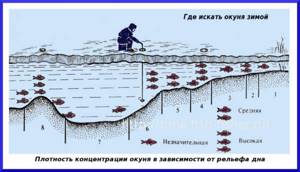
When looking for striped fish, you shouldn’t sit at one hole all day. Here it’s better not to wait until he looks into your hole, here it’s better to look for promising places yourself. If there is not a single bite for 10-20 minutes, then you shouldn’t stay here for a long time, it’s better to move on. If there is an attack, you can’t complete it successfully, try changing the game with a jig or reducing the weight of the bait. Maybe there’s a small fish there that doesn’t fit your bait in its mouth.
Also, on the first ice, it makes sense to return to earlier drilled holes. Even if there was not a single bite there. There is a possibility that a small flock of striped robbers may come here in search of food. If the bite is good, you need to catch it quickly, since the school does not stay for long. And if the bite has started, it’s better to immediately put aside all your extraneous affairs and focus on what you came here for.
☸ Search for a predator
It should be said right away that it is impossible to catch big fish where there are none. That is, if in the summer only perch weighing 200-250 g were found in the lake, they certainly did not grow and become kilograms before winter. This means that you need to fish in those reservoirs where there really is a trophy predator.
Successful catching of large perch in winter requires a significant investment of time searching for it. Sometimes you have to drill many holes before that very promising bite occurs. On many lakes and reservoirs with decent depth, hungry humpback whales sometimes come quite close to the shore to feed on the fry, which are always abundant in the reeds. It's good if this is known for certain. In this case, search activities can begin almost from the coastline. But in an unfamiliar body of water you shouldn’t linger in the coastal zone; it’s better to immediately go deeper at least 500 meters and try to fish at promising depths.
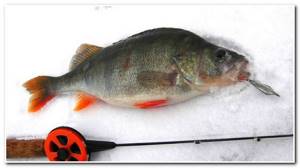
What to use to catch perch on the first ice
During the first time after freeze-up, the perch retains not only its activity, but also its location. He is still ready to grab the summer bait, but he won’t refuse the winter menu either. Since the ice is the first and the perch has been fed up after the summer and is quite strong, with a successful bite it can offer violent resistance. So you shouldn’t choose a fishing line that is too thin.
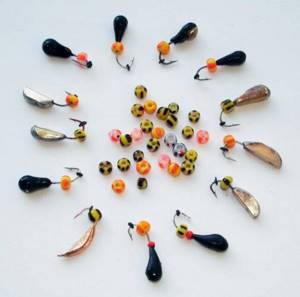
At the beginning of freeze-up, a classic jig with the usual attachments in the form of a worm, maggot, and bloodworm will give a good result. You can, of course, use a rewinder with the same success, but here, of course, you need to use it skillfully. Since there is an opinion that at the beginning of winter the perch is active and takes everything that moves and crawls into its mouth.
You can also successfully use balancers to imitate bleak, roach, and gudgeon. He is not even averse to having dinner with his relatives. Moreover, as practice shows, this is practically his main nutrition.
Lures for catching large perch

The outcome of any fishing depends on the choice and configuration of gear. Since it is intended to catch large individuals, the equipment must be appropriate. The use of rough gear using fishing lines with a thickness of more than 0.2 mm is not recommended. The best option is to use a fishing line with a diameter of no more than 0.15 mm. Such a fishing line does not act as an alarming element on the fish. It is advisable to use thin lines, but with a high breaking force. Naturally, such fishing lines are not cheap, but they are worth it. If you have some experience, then on a fishing line 0.1 mm thick you can pull out a specimen weighing about 2 kg. The main thing is to feel the moments when the fish resists as much as possible. At these moments, the line is let down and reeled in when the fish is relaxed. If you don't rush and do everything correctly, the result will always be positive.
Still, it is difficult to catch large perch with a jig because of its small size. The jig is more intended for catching perch of classic sizes, which most often bite on the jig. Paradoxically, jigs are used by both experienced and beginner winter fishing enthusiasts. If you want to catch larger fish, then you should focus on other baits, such as balancers or spoons. This approach can solve the problem. The fact is that such baits, like balancers, are aimed at catching large fish.
Catching perch in the middle of nowhere
At this time, the activity of almost all fish decreases. Oxygen reserves drop, and with it the activity of fish. The perch sinks lower and lower to a depth where there is still oxygen dissolved in the water and the water temperature is much higher. If you stay to catch it near the coastline, you can only count on small trophies. More or less large fish are all already at depth.
But it also happens that only by the middle of winter in many regions does ice just appear on the water. Then the tactics of fishing on the first ice will be more suitable here. Since our country is large and in some regions the ice may last only a couple of weeks throughout the winter, and even in the middle of winter it is impossible to say immediately and unambiguously how to catch it at such moments. Since you need to take into account a huge bunch of factors from weather conditions to living conditions.

By mid-winter, not only oxygen reserves become scarce, but also the food supply. Therefore, it would not be superfluous to feed the bass in promising fishing areas. Or rather, not the striped one itself, but its food base. If the whitebait fits, so does the perch. And don’t yawn, dear friend, try to use all your knowledge and ability to catch perch in the winter.
Types of gear: when and what to use
To ensure that the bites follow each other, and you don’t have to get bored while waiting for prey, pay special attention to the choice of gear. Fishing rods using artificial baits of various colors and sizes, as well as lures, are popular among fishermen. The final choice of gear for perch in winter rests with the fisherman, based on personal experience and convenience, and the conditions of a particular reservoir.
Sparklers

Fishing rods of various designs and artificial baits, which have been popular for catching striped predators for several years now. The design is a small spinning rod equipped with a reel (multiplier or spinning reel) and a friction clutch (to maintain the integrity of the fishing line when catching large fish). One or more hooks are placed on the spoon.
The depth of the selected reservoir determines the weight of the bait: the shallower, the lighter. The average length of the spoon is about 5-6 cm, and its shape determines the game:
- straight – the bait is suitable exclusively for a vertical position, avoiding surprises hiding under the ice;
- with a bend - when swinging, the bait deviates from playing in a horizontal position;
- with holes and ribs - their vibrations perfectly attract the attention of fish;
- a soldered-in hard hook ensures stable play for the lure;
- displaced center of gravity - quick return to the original position.
To improve the bite, we recommend using additional equipment:
- beads, a piece of brightly colored cambric (red works well, it helps to concentrate the predator’s attention on the prey);
- threads of rich colors wound on a hook;
- decoys - attach a colorful element to the side leash of the spoon.
The “hatchet” is rightfully considered one of the most effective spinners. Outwardly, it resembles an ax or a sail made of a single plate.
Balance

Another popular example of the most catchy gear for perch in winter, which is rightfully considered a “classic of the genre.” This bait is so loved by fishermen for a reason; in addition to the striped predator, you can catch other fish with it - pike, pike perch. As a standard, the balancer requires a fishing line of about 0.12 cm and a fishing rod with a long whip. The bait is attached to the fishing line with a clasp or using a loose loop. This fastening method has a great effect on his game, the rules of which we suggest you read below:
- lower the bait to the bottom;
- lift it using small strokes with an amplitude of +/- 30 cm;
- take short breaks between physical activity (about 5 seconds). Don't hesitate, but don't make hasty movements either. Monitor the behavior of the prey so as not to pull the bait out of its mouth and do not wait until the fish sinks into the water.
A few words about the size of the balancer and the shade. There is no correct color. Everything is selected according to weather conditions, turbidity of the reservoir, fishing depth, and fish activity. But the dimensions are influenced by quite understandable factors:
- in the dead of winter, use balancers up to 3 cm. This option is suitable for both cautious fish and for catching small individuals;
- 5-6 cm is the golden mean. Medium and large perches readily bite;
- bait from 7 cm is used for fishing at great depths or catching large fish.
For more than a hundred years in Russia, a proven method of catching perch in winter has been used - with a jig. There are several varieties of jigs with and without attachments. There are:
- nymph The length exceeds the width three times. The product is very light. Functions perfectly in standing water, when used in shallow reservoirs;
- flat tungsten. They fish with it in deep water and in strong currents. The weight is impressive, you need to have sufficient strength and dexterity to use this tackle;
- bug. The element consists of red copper and is light in weight. Its width is comparable to its length.
A nozzle-free jig is attached to the fishing line at a certain angle, while with a nozzle it is attached vertically.
Perch girders

Not very popular among bass hunters. This method involves constant searching and moving. It justifies itself only when there is a lot of prey and there are no competitors (pike). The design is simple, it consists of a base with a reel, a hole for a fishing line and a bite alarm - a flag with a spring. The line is set to 0.15 mm. Use girders in the dead of winter; during periods of activity it is much more pleasant to work with balancers and spinners.
The distance between gear is no more than 50 meters. Otherwise, you will not have time to react quickly, the predator will wave its tail.
Avid anglers go beyond standard methods and choose methods that defy classification. Among them are bass fishing on Baldu or Honduras. The bulldozer is a massive bronze or brass sinker with hooks and additional elements of different colors. Among the advantages of such a bait I would like to highlight the following:
- there is no influence of river depth and current speed;
- thanks to the sound of bronze and brass when tapping on the bottom, the activity of living creatures increases;
- the load does not cling, it quickly sinks towards the bottom due to its weight;
- no need to waste time on the nozzle.
Honduras
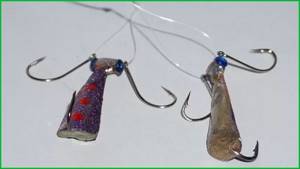
Imitation of dragonfly larvae, helps to catch large fish. It is a type of spinner in which, instead of a weight, a vertical spoon with a hole that is perpendicular to the hook is used.
The best winter lures for perch
When choosing baits and attachments for catching perch, you need to start from the fact that this is a predatory fish and therefore all baits that are suitable for a predator will work for perch. The variety and choice of baits and tackle for this business is simply amazing. What lengths do fishermen go to in order to interest perch?
- Jigs.
- Spoons of various shapes and sizes.
- Balancers.
- Silicone baits.
- Balda.
- Wobblers.
And this is not the entire list of gear with which you can successfully catch this striped robber in winter. Since we are dealing with a predator, it makes sense to catch it with animal lures and bait.
- Bloodworm.
- Caddisfly.
- Maggot.
- Pieces of liver.
- Cow's udder.
- Live bait.
- Dragonfly larva.
- Red worm.
- Pelvic fin of a small perch.
In addition to purchased attachments, people like to invent something of their own. Almost every year a new bait appears that, in all respects, works better than the old one. From this I often know that such homemade baits as:
- Ratalins.
- Spoons.
- Cicadas.
- Amphipods.
- Various flies.
- Balda.
- Edible rubber.
And each nozzle has its pros and cons. And of course, to achieve good results you need to be able to use these baits perfectly. It’s basically like in any other business, you know how to do it perfectly, but you don’t know how to do it, you’re just wasting your time. But to learn, you need to try and look for your most catchy tackle.
What are the best baits for catching perch?
The bait provides productive fishing for perch, which is especially voracious in winter. When choosing bait, you need to remember that perch is a predatory fish, so it is optimal to add animal components that suit the taste of this individual. But what do they use to catch perch in winter?
In this case, the ideal solution would be to use live bloodworms or jigs, since this type of animal life is capable of luring perch to the fishing point even during the non-biting season. In addition to animal bait, you can also use ready-made types of food, which, when they fall to the bottom, saturate the water and arouse interest in the area.

A large assortment of store-bought baits is presented in specialized stores. They contain special components to attract this predator. It is only important when baiting not to pour out the entire contents of the bag, but to observe the measure. You can create interest in a place by using live crustaceans.
Considering that perch is a predator with a developed sense of smell, it will be possible to arouse its interest using blood. So you can add chopped worms, shellfish, snails, and minced meat to the bait. To saturate the blood, it is permissible to mix it with breadcrumbs. Blood can also be added to a ready-made mixture purchased in a store or to porridge prepared with your own hands.
A tricky option would be to use a jar with live fry. To do this, a container containing a live fry is lowered to the bottom of the reservoir. This can be either an ordinary package or a jar. This method arouses the interest of perch, which is particularly curious.
There is another non-standard method that is used when all other attempts are in vain. To do this, animal bait, namely bloodworms or jigs, is poured into silicone molds with water, after which the molds are sent to freeze in the freezer. Afterwards, directly during fishing, the formed pieces of ice are sent to the bottom, where, gradually thawing, they arouse the interest of the perch.
Vegetable bait is also suitable for fishing. The crumbly mixture falls apart in water, resulting in a cloudy cloud. This cloud attracts the attention of small fish, which creates a fuss around the hole. Such an abundant presence of small fish in the water will certainly attract the attention of perch. To improve the result, it is recommended to add animal components to the composition, which will enhance the smell of the composition.
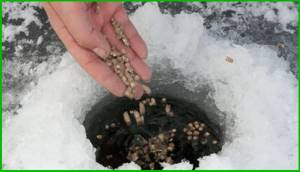
You can also play on the perch’s sense of smell using a flavoring agent and an attractant. It is best to give preference to the smells of bloodworms, fish or blood. You can purchase a ready-made version at a fishing store. Such additives are sold in the form of sprays, which are very easy to use.
Winter perch on a spinner
Every winter, a huge amount of fish is caught with the help of spoons, and perch is no exception. In winter, the same rule applies as in summer: the larger the bait, the larger and larger the trophy. But there will be fewer bites since the small one will not pay attention to the bait that is too tough for him.
Naturally, each spinner is an individual game and you need to choose your own game for each. It is advisable to already know what animation a particular bait has before going fishing. This is quite easy to do. Fill a bathtub or a large basin with water and check how the lure behaves during different types of fishing with a fishing rod.
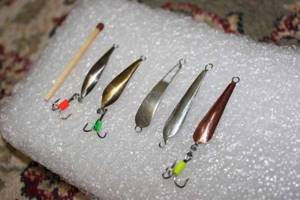
One of the most common spinner games is to sharply throw the bait to a height of up to half a meter, and then release it into free flight. And we repeat this 2-3 times, then a short break and flights again. You can choose an option with a smooth rise with slight accelerations. In terms of the height of the spinner, you are limited only by the size of your height. Then back into free fall. Here is a list of the most popular spinners that work well for perch.
- Nils Master Hanski
- Kuusamo Sinfonia
- Kuusamo Kilpa-Loiste
- Kuusamo Leija
- Hali Lindroos Luxus
- Rapala Bergman BWB030 SG
- Rapala SM-Pirken SM45-SG
Lures and fishing methods
The unpretentiousness of perch in food has contributed to the creation of a large number of baits for perch hunting. The modern angler has a rich arsenal of all kinds of gadgets for fishing. Moreover, special tactics have been developed for each device. In order not to get confused in the types of baits, it is necessary to organize the information into main categories.
Jigs
The most popular tackle for perch in winter is a jig. The secret of success is simple: the fish are very willing to make contact with the tackle. The bait provides guaranteed results in a short period of time. Bloodworms or maggots will work as bait.
There are jigs of different shapes: a drop, a ball, an imitation of an insect larva and many others. The choice of bait size should be approached responsibly, since a certain option is suitable for different conditions. In shallow water, a jig measuring 1-2 mm will be appropriate, in severe frosts - 3-4 mm, and for deep water, a nozzle larger than 5 mm will be the best option.
The most common baits are tin, tungsten and lead. The color spectrum for decorating a part is varied. Often fishermen add the necessary tone to the jig with their own hands. The most popular bright, “screaming” colors. Sometimes a boundless flight of imagination helps to create a unique device, decorated with beads and threads.

A set of jigs for winter fishing
A compact balalaika rod is ideal for catching perch with a jig.
The technology of using the device is associated with vertical movements of the bait in the water, imitating the behavior of small fish. Fishing tactics involve following certain techniques:
- The jig sinks to the bottom and then, with sharp but short twitches, is pulled up 20 cm from its original position. This cycle is repeated until the first bite occurs.
- In another case, the amplitude of the bait’s oscillations is increased to 45–50 cm, and jerks are performed with different forces.
- Another method is associated with the bottom activity of the bait. The fisherman performs a series of sharp and short movements within an interval of 10 cm from the bottom point of the reservoir with a break of 2–3 seconds.
- After the bait reaches the bottom, the fisherman makes several more “knocks” on the lower limit of the reservoir. As a result of the manipulations, a cloudy cloud is formed, which arouses the interest of the perch.
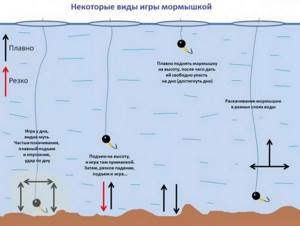
This set of rules is aimed primarily at beginners. Over time, each professional develops his own algorithm of actions that helps achieve the desired results.
Mothless
An alternative name for the bait is a nozzle jig. The name of the device indicates the specifics of its application. Fishing with a reelless bait does not require a hook attachment. The unique appearance of the device resembles insects, crustaceans and other creatures that perch feed on.
The size and color of the bait are selected in practice, and therefore it is advisable to always have several different models available. With the color scheme the situation is more definite. Common devices are treated with gray and black paint.
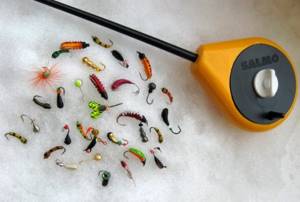
Reelless jigs for winter fishing
The technique for catching perch with a reelless reel is largely the same as for using a jig. The essence of the game comes down to recreating the movements of the victim, which will interest the merciless river killer. The standard set of techniques includes vertical oscillations using sharp jerks or smooth movements.
The nozzle will not allow the hunter to get bored. The fisherman must concentrate as much as possible on the process and continuously flirt with the fish. This level of mastery of the craft requires honed professional skills. It is better for beginners to take their first steps on a jig.
Flashing
Specialized stores are ready to offer catchy lures for every taste and budget. The range of baits is huge, but among the variety there are leaders.
Brass, tin or copper baits have a discreet appearance and small format - they should be given priority. Such baits have proven themselves well among experts in the craft.
The tactics are carried out in stages:
- The depth of the location is calculated.
- The spoon is immersed and fixed at a short distance from the bottom.
- A vertical jerk is made with an amplitude of up to half a meter, and then the bait is lowered to its original position naturally. Chaotic motor skills are close to the movements of fry and captivate the perch with unusual behavior.
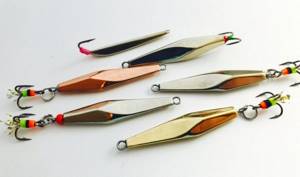
The cycle of actions is repeated until a positive result occurs. If no bite is observed, a gradual change in depth and fishing of all layers of water is required.
Balance
A balancer is an artificial fishing bait that looks like a real fry. When immersed in water, the tackle is positioned in a horizontal plane, thereby achieving similarity to the behavior of live fish. A typical design has two hooks: in the head area and on the caudal fin. Sometimes there is a modification with a third hook on the abdomen.
The average size of a perch does not have outstanding parameters, and therefore a miniature bait format of about 3 cm has proven itself well. Balancers of 4–5 cm are the gold standard. These universal baits allow you to hunt small and large perches equally successfully.
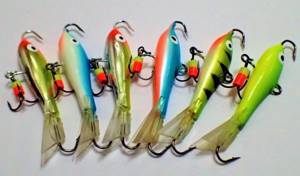
There is no unambiguous recipe for choosing the shape of the bait; everything here is individual. It's better to experiment with several devices and find the right one. Priority in the color composition is given to the natural colors of aquatic inhabitants.
Wiring technology is performed in 3 simple steps:
- Immerse the nozzle all the way.
- Slightly raise the dummy above the bottom plane and sharply swing it 30 cm.
- Return to starting position.
The specified program is repeated until the bite begins.
Balda
Balda has gained popularity among ice fishing fans. The structure is usually set up at home from scrap materials. The part consists of three main components:
- A large load in the shape of a truncated cone.
- Several hooks.
- Decorative elements (colored beads and threads).
The process of creating a bait begins with making a loop at the edge of the fishing line. A sinker is attached to the base of the artificial rim, and there are 2 hooks on the sides with free sliding along the thread. Decorations are attached to the non-working area of the hooks.
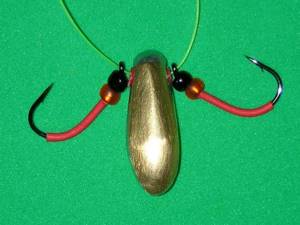
Fishing tackle Balda
The sinker of the required weight is selected depending on the characteristics of the reservoir and the size of the potential prey. For an impressive “anchor” you will need a powerful fishing rod with a reel and a nod that can withstand overloads.
The technique for catching perch on a bulldozer is as follows:
- The structure sinks to the bottom.
- With explosive acceleration, the bait rises 16–20 cm.
- The grip weakens, and the bulldozer naturally returns to its original state.
- There is a pause of 5–10 seconds.
The cycle is repeated until the bite occurs. The vertical swaying of the bait creates a muddy area around it, imitating the activity of real river inhabitants. Unrest in the water layers attracts large predators to the area of action.
Fishing with live bait
This is the name given to small fish included in the diet of perches. As live bait they select bleak, bystryanka, gudgeon, verkhovka and other small things.
Fishing with live bait has distinctive features:
- Holes are made in the immediate vicinity of the shore, in areas with underwater vegetation, as well as on flooded snags. Suitable areas are selected based on the natural habitat of small food during the cold season.
- It is necessary to systematically check the condition of live bait. Perch will quickly lose interest in dead bait.
- Several weights are attached to the system to better fix the bait in the water column.
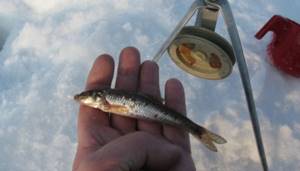
Winter fishing with live bait
The live bait is carefully attached to the hook by the back so as not to touch important organs and kill the bait prematurely. The active behavior of the fry will attract the attention of the perch.
Technique for catching winter perch with a jig
The jig also occupies one of the leading places in catching perch in winter. This little bait is over a hundred years old. And she does not give up her leading position.
There are two options for fishing with this tackle: classic tackle where animal bait is used, and without bait fishing where, instead of natural bait, the fish are presented with a beautiful game with a jig, it is on this game that the fish bite.
For classic fishing, the following baits are used:
- Bloodworm.
- Mormysh. You can take it fresh, or you can take it boiled.
- Classic red worms.
- You will maggot.
- Dragonfly larvae.
- Pieces of liver.
- Artificial baits.
Catching perch with such bait takes place in the following way. Usually the bait is placed on the bottom and then set in motion with slight twitches. The twitching is carried out very smoothly so that the nod of the rod bends slightly from the tension of the fishing line. Then we give a short pause of 10-15 seconds and repeat again. The attack can take place both on a moving bait and on a standing one. If there are no bites, you should slightly modify the game, change the fishing depth or change the location.
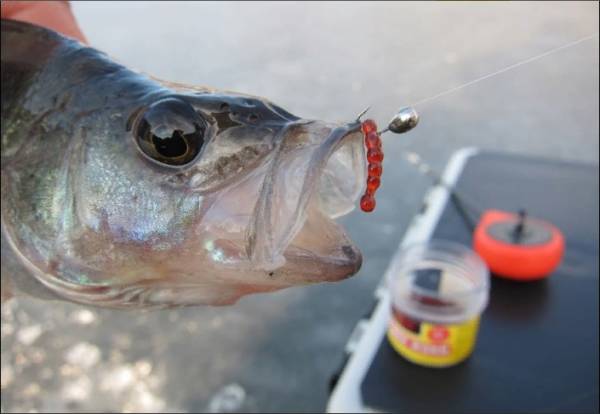
Nozzle-less equipment or a rewinder has also helped out striped robber hunters more than once. Sometimes her game can provoke even a very inactive perch. Sometimes it is this species that allows many fishermen to return home with their catch.
Tackle for catching perch in winter
In any fishing, gear plays an important role. They must be of high quality and correctly selected, otherwise the entire fishing will be ruined.
Fishing for perch in winter will be successful with the following gear:
- Fishing rod. Thin and flexible, more than 10-15 cm long.
- Reel _ There are no special requirements; the simplest inertia-free one will do. It is convenient for fishing with its help, but many fishermen successfully catch perch on a reel.
- Fishing line. As thin as possible, up to 0.06 mm - the fishing line is very noticeable in winter water, so a predator may simply not approach. Depends on the size of the prey. The average size is 0.08-012 mm. It can reach up to 0.2-0.25 mm.
- Nod. Shape – cone-shaped, hardness – medium. Length – up to 10 cm. Material – polycarbonate or metal. You can also use the nods of their lavas and corporal - they have greater resistance to side winds.
The nod should bend slightly under the weight of the bait - this will ensure good play with the bait.
What to use to catch perch on a river in winter
Perch successfully lives both in lakes and rivers of our vast country. And with the arrival of winter, many fishermen go in search of minke whales to the nearest water area.
But in order to start catching, you need to at least roughly understand where to look for it? Where might minke whales be moored? Experienced fishermen know that it is not worth looking for perch closer to the middle of the river since it will not be able to feed itself at the depth of the river. Therefore, it is worth looking into places where he can easily get food for himself.

It is worth paying attention to such places as small creeks, the edge of coastal vegetation; if there are fallen trees, then this is simply an excellent place for an ambush. Perch does not stand in one place; it is constantly on the move, so you simply cannot do with one hole on the river. It is worth looking for it in various convenient places.
Also, a number of obviously promising places can be identified along the river.
- Shallow waters and shoals.
- Pools or dumps in front of pits.
- Edge of depth difference.
- All sorts of backwaters, bays.
- Places with quiet currents.
- Thickets of reeds.
Places with snags, fallen trees or bridge supports are also considered interesting.
